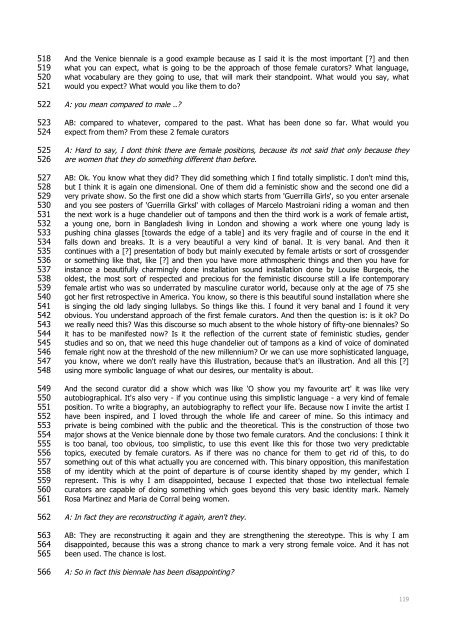Dekonstruktion von Zweigeschlechtlichkeit - anita.a.mörth
Dekonstruktion von Zweigeschlechtlichkeit - anita.a.mörth
Dekonstruktion von Zweigeschlechtlichkeit - anita.a.mörth
Sie wollen auch ein ePaper? Erhöhen Sie die Reichweite Ihrer Titel.
YUMPU macht aus Druck-PDFs automatisch weboptimierte ePaper, die Google liebt.
518<br />
519<br />
520<br />
521<br />
522<br />
523<br />
524<br />
525<br />
526<br />
527<br />
528<br />
529<br />
530<br />
531<br />
532<br />
533<br />
534<br />
535<br />
536<br />
537<br />
538<br />
539<br />
540<br />
541<br />
542<br />
543<br />
544<br />
545<br />
546<br />
547<br />
548<br />
549<br />
550<br />
551<br />
552<br />
553<br />
554<br />
555<br />
556<br />
557<br />
558<br />
559<br />
560<br />
561<br />
562<br />
563<br />
564<br />
565<br />
566<br />
And the Venice biennale is a good example because as I said it is the most important [?] and then<br />
what you can expect, what is going to be the approach of those female curators? What language,<br />
what vocabulary are they going to use, that will mark their standpoint. What would you say, what<br />
would you expect? What would you like them to do?<br />
A: you mean compared to male ..?<br />
AB: compared to whatever, compared to the past. What has been done so far. What would you<br />
expect from them? From these 2 female curators<br />
A: Hard to say, I dont think there are female positions, because its not said that only because they<br />
are women that they do something different than before.<br />
AB: Ok. You know what they did? They did something which I find totally simplistic. I don't mind this,<br />
but I think it is again one dimensional. One of them did a feministic show and the second one did a<br />
very private show. So the first one did a show which starts from 'Guerrilla Girls', so you enter arsenale<br />
and you see posters of 'Guerrilla Girksl' with collages of Marcelo Mastroiani riding a woman and then<br />
the next work is a huge chandelier out of tampons and then the third work is a work of female artist,<br />
a young one, born in Bangladesh living in London and showing a work where one young lady is<br />
pushing china glasses [towards the edge of a table] and its very fragile and of course in the end it<br />
falls down and breaks. It is a very beautiful a very kind of banal. It is very banal. And then it<br />
continues with a [?] presentation of body but mainly executed by female artists or sort of crossgender<br />
or something like that, like [?] and then you have more athmospheric things and then you have for<br />
instance a beautifully charmingly done installation sound installation done by Louise Burgeois, the<br />
oldest, the most sort of respected and precious for the feministic discourse still a life contemporary<br />
female artist who was so underrated by masculine curator world, because only at the age of 75 she<br />
got her first retrospective in America. You know, so there is this beautiful sound installation where she<br />
is singing the old lady singing lullabys. So things like this. I found it very banal and I found it very<br />
obvious. You understand approach of the first female curators. And then the question is: is it ok? Do<br />
we really need this? Was this discourse so much absent to the whole history of fifty-one biennales? So<br />
it has to be manifested now? Is it the reflection of the current state of feministic studies, gender<br />
studies and so on, that we need this huge chandelier out of tampons as a kind of voice of dominated<br />
female right now at the threshold of the new millennium? Or we can use more sophisticated language,<br />
you know, where we don't really have this illustration, because that's an illustration. And all this [?]<br />
using more symbolic language of what our desires, our mentality is about.<br />
And the second curator did a show which was like 'O show you my favourite art' it was like very<br />
autobiographical. It's also very - if you continue using this simplistic language - a very kind of female<br />
position. To write a biography, an autobiography to reflect your life. Because now I invite the artist I<br />
have been inspired, and I loved through the whole life and career of mine. So this intimacy and<br />
private is being combined with the public and the theoretical. This is the construction of those two<br />
major shows at the Venice biennale done by those two female curators. And the conclusions: I think it<br />
is too banal, too obvious, too simplistic, to use this event like this for those two very predictable<br />
topics, executed by female curators. As if there was no chance for them to get rid of this, to do<br />
something out of this what actually you are concerned with. This binary opposition, this manifestation<br />
of my identity which at the point of departure is of course identity shaped by my gender, which I<br />
represent. This is why I am disappointed, because I expected that those two intellectual female<br />
curators are capable of doing something which goes beyond this very basic identity mark. Namely<br />
Rosa Martinez and Maria de Corral being women.<br />
A: In fact they are reconstructing it again, aren't they.<br />
AB: They are reconstructing it again and they are strengthening the stereotype. This is why I am<br />
disappointed, because this was a strong chance to mark a very strong female voice. And it has not<br />
been used. The chance is lost.<br />
A: So in fact this biennale has been disappointing?<br />
119


